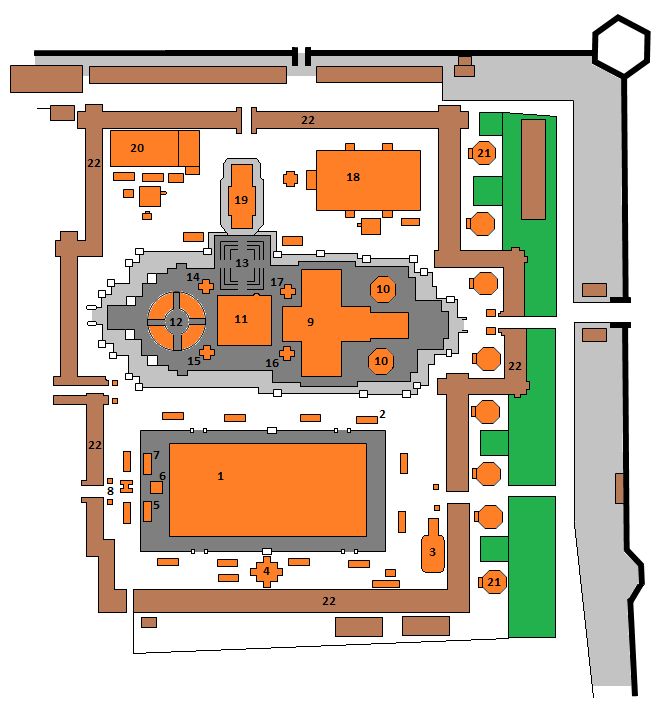The temple of the Emerald Buddha is quite impressive, there are magnificent buildings in color, with beautiful gilding. In each corner one can find an interest, a small statue, a painting, anything that catches the eye. But it must be said that there is much to see on site. Here below is the site plan, with the main buildings.
Map of the temple

1. The ubosoth
2. Twelve small pavilions
3. Vihân of the Buddha Gandhara
4. Tower of the bell
5. Ho Rachapongsanusorn
6. Phra Pothithat Piman
7. Ho Rachakaramanusorn
8. Figure of a seated hermit
9. Royal Pantheon
10. Two golden stupas
11. Phra Mondop (Library)
12. Phra Si Ratana Chedi
13. Model of Angkor Wat temple
14. Monument of the kings Râma I, II and III
15. Monument of the king Râma IV
16. Monument dof the king Râma V
17. Monument of the kings Râma VI, VII, VIII and IX
18. Ho Phra Monthien Tham (Additional library)
19. Vihân Yod
20. Ho Phra Nak
21. Height prangs
22. Galeries
Main elements
Apart from the usoboth all the buildings of the temple are closed, it will be necessary to observe them from the outside, which is already very good. the main one is the Usoboth, a tall rectangular building with elaborate roofs that contains the famous Emerald Buddha. there are rules to follow when you enter (see visiting the temple). The other buildings are on the central terrace: The Royal Pantheon, the Library and the Phra Si Ratana Chedi, three buildings lined up dotn you will tour to admire the details. You will come across the model of Angkor Wat and the "small" memorials of the deceased members of the royal family.
Some explanations
The usual entrance to the site is that of the North, you will enter the temple between Ho Phra Monthien Tham (Additional Library) and Vihân Yod, two buildings that may go unnoticed in front of others. Starting with the usoboth can be a good idea because it forces you around the large terrace that occupies most of the site, revealing the marvelous buildings that are there without approaching you too much. Visit the usoboth, then return to the terrace. Once this tour is complete you will have spent a lot of time there as these are the main buildings to see. But between each of them you will linger on a small simple buildings (at least that seems), on a statue, on paintings, in short, there is always something that will attract your attention before going a little more far.
The large gallery can be visited in several places. Some are alignments of statues of Buddhas, all identical. Others are beautiful paintings explaining the Râmakayen. The Ramakayen is the story of the Thai nation told by popular tradition, it is the national narrative. Here it is declined in the form of beautiful large format paintings and small explanatory texts ... in Thai language ... If you are curious you must learn before going on site on this story, in the end, the story is not that complicated and it allows to understand these paintings.
Aside from the usoboth buildings are usually closed, so you will not be able to access them. This is normal, we must not forget that we are on a religious site. The royal pantheon, for example, opens only for a few ceremonies. But nothing outside you will have enough to satisfy you, the buildings are beautiful. The model of Angkor Wat, it is rather surprising here. Carefully made, it is a faithful reproduction of the Khmer temple. It dates from the time when the king of Thailand tried to conquer the territory on which it was built in order to dismount stone to stone and back near Bangkok. The military expedition was a fiasco and all the king could afford was this model. Hence his presence here, within the walls of the royal palace.
A curiosity not to be missed, and that any way you can not miss, it is the presence of the guards of the entered of the temple. There are several, two per door, and these are statues beautifully worked 5m high perched on massive pedestals. They are reproductions of demonic creatures that aim to protect the temple from enemies. These demonic creatures were made in the image of monsters in the popular imagination of the local population, who are ... Westerners. And yes, the guardian monsters of the Emerald Buddhas are "long-noses", the nickname of Westerners.

















